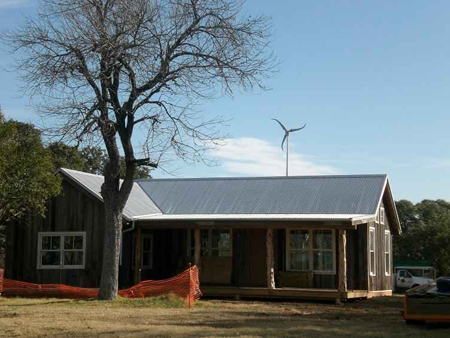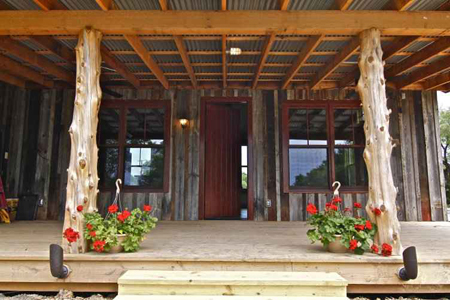We’ve covered a lot of green home new builds, conversions and rebuilds since launching EarthTechling, finding that most of these properties, with certain exceptions, hold true to such lofty goals as being energy efficient and sustainable. One such project getting set to open on June 5th Fort Worth, Texas, is a net zero design home called the Zero Energy Casita.
The Zero Energy Casita, designed by renowned Texas custom green homes builder Don Ferrier, is so called this because it combines a variety of energy efficiency techniques with on-site energy generation from a wind turbine. It was built on an infill lot, which had been previously developed, using a variety of non-toxic building materials (many of which were reclaimed). LEED certification will be likely, with the home already sporting a bunch of other green-based labels such as Energy Star. We recently interviewed over email Ferrier to find out about this unique home as well as what net zero homes are all about. His answers have been slightly edited for brevity and clarity.

EarthTechling: What exactly is a net zero energy home?
Don Ferrier: Simply put, it is a home that produces as much energy as it consumes.
ET: What goes into building a home such as this? What factors have to be taken into consideration?
Ferrier: It is a “Whole House” approach that looks much like the well know food pyramid:
- The foundation base level consists of passive solar orientation, a “Building Envelope” with great air tightness & insulation, preferably a light colored metal roof that reflects most of the suns hot summer heat back, proper shading of all glass/glazing areas (windows and doors with glass) to prevent the hot summer sun from coming into the Building Envelope, high efficient Energy Star windows and doors, etc.
- The middle level consists of somewhat more costly elements such as a high efficiency air conditioner, more effective means to heat hot water (solar heater or tankless heater), high efficient Energy Star appliances & lighting, ERV (Energy Recovery Ventilator) for a moderate climate or an HRV (Heat Recovery Ventilator) for a cold climate, etc.
- The top level consists of more expensive items such as PV (Photovoltaic) solar arrays, wind turbines, etc. to generate electricity..
The key to make this as affordable as possible is to capitalize on the elements on the foundational level that increase cost as little as possible but increase the efficiency of the house and minimize the costly elements as much as possible, i.e. – make a home as tight and energy efficient as possible then add additional items that increase efficiency and generate electricity.
ET: How do upfront costs of developing a home like this compare to a typical new suburban dwelling?
Ferrier: The upfront cost typically consist of a greater degree of planning and energy modeling, often utilizing a building science firm to confirm the use of products and systems that will work together synergistically to achieve net zero energy. For our Zero Energy Casita we spend about $450 with such a firm and spent probably another 30 hours in additional planning. We do have a 28 year history of building near zero energy homes that we pull into every project that gives us a great head start on what works and what doesn’t work.
ET: What went into building the Zero Energy Casita? What makes it unique in your opinion?
Ferrier: It is a great example of carefully thought out planning and modeling. We started with the owners’ previously drawn plans, tweaked them to increase the energy efficiency of it in such areas as shading, overhangs, location on the site to maximize shading from 50’ existing trees and 30’ existing shrubs and placement and sizing of windows. Then we explored options and ran them through an energy modeling process to confirm choices of our extremely energy efficient 6.5” SIP (Structural Insulated Panel) walls and 10.25” SIP roof panels, Weather shield windows with ZOE-5 glazing system, ThermaTru doors, vented Galvalume metal roof, High efficiency Carrier AC units, Seisco Tankless hot water heater, SkyStream 3.7 Kw Wind Turbine, Energy Star appliances and lighting, etc.

ET: Can consumers except to see more homes like the Zero Energy Casita in their cities soon?
Ferrier: I believe we will see a steady increase in the number of such homes. With the continual increase in energy costs, folks concerned with our dependence on foreign oil and the increasing sentiment of wanting to be independent, combined with the increasing desire to “invest in our own homes instead of the power companies”, is driving the great interest in such homes and the acceleration of their construction.